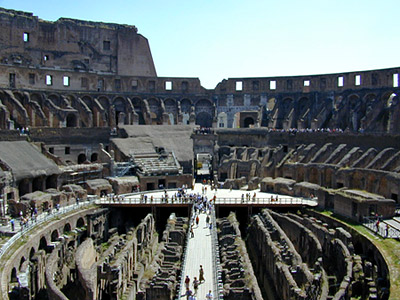
This picture gives an idea of how the arena was related to the substructures, though the wooden walkway is of course modern.
From the darkness of the lower levels you emerge through a trapdoor into the bright sunlight and hot sand of the arena. You are amazed by the huge size of this elliptical area, 287 feet by 180 feet. You realize how dangerous is the space where you now stand when you notice that walls nearly 15 feet high separate you from the spectators in the first rows.
The floor of the arena was made of wood covered with sand (hence its name, from harena, "sand"), which could easily be swept up and replaced when it had absorbed too much blood. Below the floor large and small openings covered with wooden trapdoors allowed access from the substructures for animals, prisoners, and other participants in the performances; the above photo of the arena at Capua gives some idea of the nature of these openings, and this nineteenth-century photo shows the Colosseum when the arena was only partially excavated.
Along the four principal axes of the arena were entrances that led directly from the street through monumental arches into the arena (compare the much smaller amphitheater at Uthina in Tunisia). Through one of these marched the procession (pompa) that began the day's festivities, which were called munera, which carries the meaning of "duties," especially the obligations that wealthy and fortunate citizens owed to the state.
Learn more about a typical day at the arena, and explore the objects here to experience a venatio (animal hunt), an execution, a gladiatorial combat, and a naumachia (naval battle). To see where you are, look at this navigational plan of the virtual site.